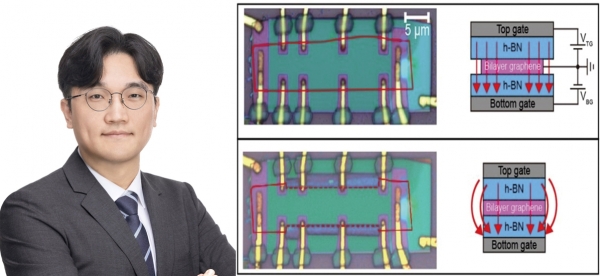
A research team led by Professor Gil-Ho Lee (PHYS) along with Hyeon-Woo Jeong (PHYS Ph.D. student) collaborated with Dr. Kenji Watanabe and Dr. Takashi Taniguchi from the National Institute for Materials Science (NIMS) in Japan to uncover the effects of edge states in bilayer graphene on electron transport and non-local transport mechanisms. This research was published in Nano Letters.
Bilayer graphene, a material consisting of two layers of graphene, can control the bandgap, which plays a crucial role in electron movement, using external electric fields. This feature has made it a key material for “valleytronics,” a next-generation information technology that surpasses conventional transistors. Valleytronics is a technology that uses the “valley,” a specific information storage unit in the electronic energy structure, allowing for faster and more efficient data processing.
One important concept in valleytronics is the “valley Hall effect,” where electrons move along a specific energy state (valley) within the material, causing the flow of electrons to split in different directions. This results in a unique phenomenon called “non-local resistance,” where resistance appears in places where no current should flow.
To investigate the cause of non-local resistance in bilayer graphene, the team created graphene devices with adjustable band gaps using a dual-gate structure. They compared the electrical characteristics of naturally formed edges and those processed through reactive ion etching, a microfabrication technique that uses plasma to selectively remove material. The results showed that non-local resistance values were consistent with predictions at the naturally formed edges. In contrast, the resistance at the etched edges was over 100 times higher than expected, due to additional conduction pathways unrelated to the valley Hall effect.
Lead author Hyeon-Woo Jeong stated, “This study provides an important clue for the design and development of valleytronics devices.”
This research was supported by the National Research Foundation of Korea, the Ministry of Science and ICT, the Korea Institute of Information and Communications Technology Planning and Evaluation, the Air Force Office of Scientific Research, the Institute for Basic Science, the Samsung Future Technology Development Project, Samsung Electronics, the Japan Society for the Promotion of Science (JSPS KAKENHI), and the World Premier International Research Center Initiative (WPI).


